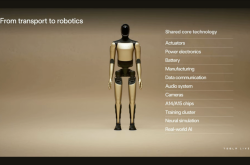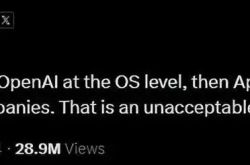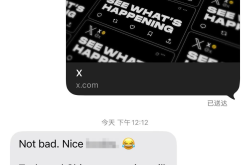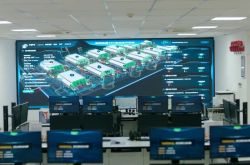The 'Extended Range Cult' is getting more lively
![]() 09/20 2024
09/20 2024
![]() 499
499
Are pure electric car companies turning back to extended range? Will Lixiang and AITO, now well-fed, turn to pure electric vehicles?
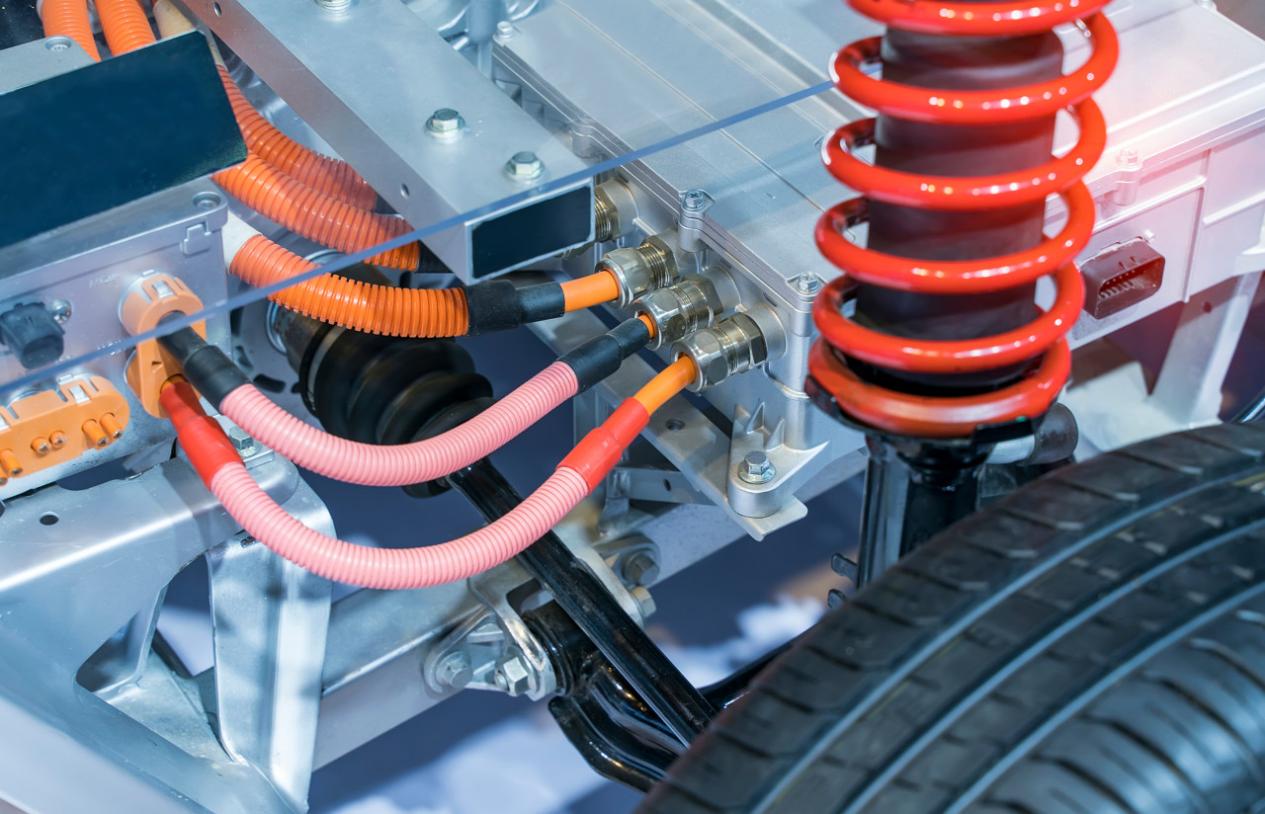
The 'Extended Range Cult' is getting more lively.
In addition to NIO, a loyal advocate of pure electric vehicles, many new auto players have begun or already bet on extended range as their next growth point.
According to 36Kr, as of September this year, Xpeng's extended-range vehicle project has become clear, with core components fixed point completed in the first half of the year, and the first extended-range vehicle is being developed at full speed, with mass production expected in the second half of 2025.
Specifically, sources have revealed that Xpeng's extended-range model is a mid-to-large SUV "developed based on the G9 prototype, targeting the price range above 200,000 yuan," and the launch time "will not be later than the fourth quarter of next year," at which point Xpeng will also form a product lineup consisting of both pure electric and extended-range vehicles.
Apart from Xpeng, Xiaomi was also rumored to be planning a family-oriented extended-range SUV several months ago, which may be launched in 2026. IM Motors, which inherits Xiaomi's spirit, is also rumored to launch an extended-range SUV targeting the Lixiang L7 in the first quarter of 2025. Even Geely's pure electric brand Zeekr has hinted at entering the extended-range market, with CEO An Conghui stating at the ZEEKR 009 launch event that "we do not rule out the possibility of developing extended-range hybrids in the future" when asked about such plans.
Furthermore, the key extended-range products in the second half of this year, such as the Leapmotor C16, AVATR 07, and SL03 S05, are almost ready to be unveiled to the public.
This coincides with Li Xiang's bold prediction at the end of last year.
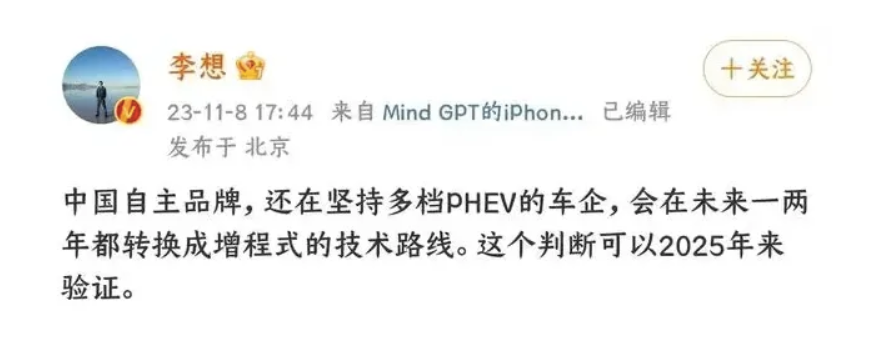
Image source: Li Xiang's Weibo
It has been four years since the CEO of Volkswagen China lambasted Lixiang's promotion of "extended range as the worst solution." During these four years, the share of extended-range vehicles has continued to increase, even accelerating further in the past year, with sales share growth exceeding 5%. In contrast, the share of pure electric new energy vehicles has fallen from nearly 70% a year ago to just over 50% in July of this year.
So, why has extended range, a technology that has been publicly denounced as outdated by executives from established automakers like Volkswagen and Great Wall, been able to "reverse history" despite batteries achieving new highs in range, and continue to thrive? As the "cult" of extended range grows, should Lixiang and Hongmeng Zhixing, who were once comfortably ensconced in their niches, be concerned about the future of their pure electric vehicles?
01
Do pure electric car companies that understand technology not understand Chinese consumers?
To understand why so many new energy vehicle companies have turned to extended range, it's natural to address the shortcomings of this technology. In summary, there are three main drawbacks: significant power loss during battery depletion, slower charging speeds, and louder noise when the range extender is engaged.
These three drawbacks are inevitable for an extended-range vehicle that carries a "power bank."
As is well known, extended-range vehicles often employ a serial combination of a "small battery + large fuel tank." When the battery cannot support pure electric mode, the range extender must intervene to convert fuel into electricity and then into kinetic energy. However, most current engines are inefficient compared to electrical consumption, making it difficult for the motor to output at full capacity, leading to significant power loss during battery depletion.
Furthermore, the inefficiency of the engine also makes the range extender the weakest link in the extended-range power system. Operating at high loads during battery depletion results in significant noise, even with noise reduction efforts by automakers. Compared to the experience of pure electric vehicles, this is a significant drawback.
Finally, the small battery capacity also limits the charging efficiency of extended-range vehicles, making them less competitive with mainstream pure electric models and leading to instances where charging stations have "refused" to charge them.
Four years ago, any pure electric car company looking at the continually improving driving range and rapidly expanding charging infrastructure would have dreamed of a future with long range, fast charging, and abundant charging stations. The idea of running around with an engine was dismissed as a technology that would soon be obsolete.
However, automakers that pride themselves on their technological expertise underestimated the Chinese consumer's reliance on the "security" of fuel.
As the mainstay of extended-range technology, SUVs naturally attract a large proportion of family users. These users' daily lives are mostly centered in urban areas, with short daily travel radii. Even in cities like Beijing and Shanghai, known for their long commutes, the round-trip distance is rarely more than 100 kilometers, which can be easily covered by the pure electric range of an extended-range vehicle.
While most commutes are short, family users demand high refueling efficiency.
Li Xiang once shared a personal example: "When I drive long distances, I don't mind spending an hour or two charging alone. I can read my phone or even play a game while looking for a charging station. But if I'm with my wife, parents, and children, looking for a charging station and waiting in line is a disaster! Especially during holidays, when there are four to five times as many people charging as usual."
By increasing the pure electric range of extended-range vehicles to 150 km, Lixiang introduced the classic "dad car" prototype of the Lixiang ONE and captured a share of the Chinese high-end family SUV market.
Following in Lixiang's footsteps, the success of Huawei's "Lixiang-like" AITO brand and the popularity of the "budget Lixiang" Leapmotor further solidified the dominance of extended-range vehicles in the market. The top three spots in weekly new energy vehicle sales rankings are almost always occupied by extended-range models, seemingly telling other automakers, "Join the cult of extended range and enjoy the feeling of selling out your products."
Repeated demonstrations like these have convinced automakers that once sneered at extended range to take notice and reconsider their strategies.
02
The "Chaos Era" of Extended Range: Lixiang and Huawei Accelerate Their Breakout
However, even though these pure electric automakers that have turned to extended range may have missed the golden age of its development, and the future remains uncertain as everyone rushes in, I don't think the ones who are truly panicking are automakers like Xpeng and Xiaomi.
As more and more automakers try to enter the extended-range market, the window of opportunity for natives like Lixiang and Hongmeng Zhixing to "break out" is closing rapidly.
After all, neither of these companies has yet to introduce a pure electric vehicle that can make a splash in the market.
Lixiang, once the undisputed leader among new energy vehicle brands, stumbled hard upon entering the pure electric market. Before entering 2024, Lixiang consolidated its position as the king of new energy vehicles with its three best-selling extended-range SUVs: the L7, L8, and L9. It quickly formulated a strategy to expand into pure electric vehicles, announcing plans to release the MEGA in March and three pure electric SUVs in the second half of the year. Among them, the M9 and M8 were scheduled for mass production in 2024, with the M7 expected in the first quarter of 2025. In February, Li Xiang, the founder and CEO of Lixiang, confidently stated that 2024 would be an unprecedented year of product launches for the company, with a product lineup of "4+4" (four pure electric models and four extended-range electric vehicles) by the end of the year.
However, the unconventional design of the MEGA sparked controversy, with only 3,200 pre-orders in the first 72 hours after its launch. Despite initial sales projections of 80,000 units per year, the MEGA sold only 3,229 and 1,145 units in its first two months on the market.
Facing the setback of the MEGA, Lixiang quickly reflected and adjusted its strategy. According to a report by LatePost, Li Xiang wrote in an internal letter on March 21 that Lixiang had misjudged the pace of its pure electric strategy, mistakenly treating the "from 0 to 1" phase (commercial validation) of the MEGA as the "from 1 to 10" phase (rapid growth).
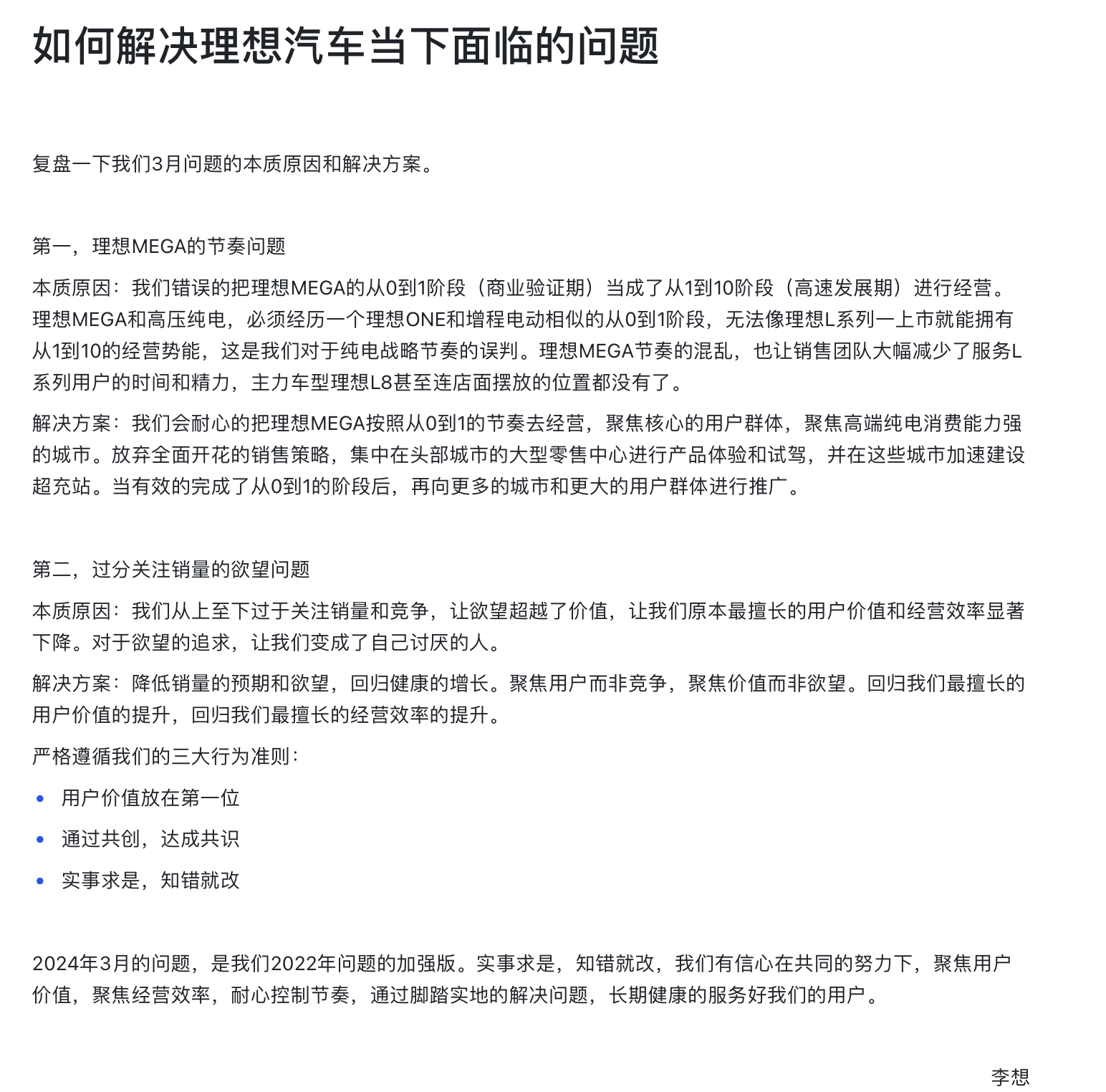
Image source: Li Xiang's internal letter
Furthermore, during a conference call announcing Lixiang's first-quarter financial results, Li Xiang admitted that the company would not release any pure electric SUV products this year and would instead focus on them in the first half of next year. He emphasized that selling mid-to-high-end pure electric SUVs requires a sufficient number of self-operated supercharging stations, and that the company would consider launching its products only when it has a comparable number of supercharging stations to Tesla China.
Regardless of how much Lixiang reflects on its strategy or how many delays it faces with its pure electric models, entering the high-end pure electric market is inevitable. However, even if Lixiang builds charging infrastructure similar to NIO's and is willing to listen to consumer needs, it will still need to compete fiercely in the pure electric market.
Compared to Lixiang, which has retreated after being taught a lesson by the market, Hongmeng Zhixing has been more stubborn. Unfortunately, despite multiple attempts, its pure electric models launched in partnership with Chery and Beijing Automotive Group, under the Zhide and Xiangjie brands, have struggled to sell.
In November last year, Huawei and Chery unveiled the Zhide S7, a mid-to-large pure electric sedan. However, delivery of the vehicle was repeatedly delayed after the launch, and in the first four months after delivery began, total sales barely exceeded 2,000 units. Despite blaming production capacity issues rather than the car itself for the slow sales, Huawei lowered the prices of all three Zhide S7 models by 20,000 yuan in April of this year in an attempt to boost sales. This combination of a price cut and relaunch did initially boost sales, but they quickly declined again, with sales falling below 1,000 units in August, marking an unsuccessful first foray into the pure electric market for Huawei.
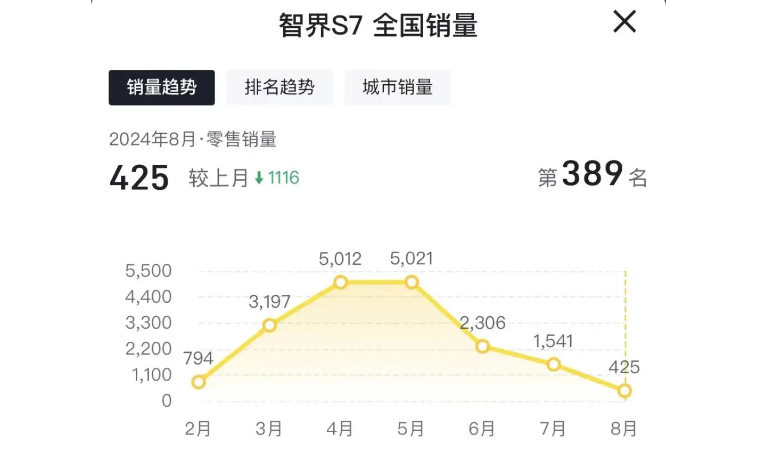
Image source: Autohome
As Zhide's sales continued to decline, Xiangjie, Huawei's other brand, also struggled to replicate the success of AITO. After the launch of the Xiangjie S9, Yu Chengdong revealed that the car had received 4,800 pre-orders within 72 hours of its debut. However, according to data from car enthusiasts, total orders for the Xiangjie S9 reached only 7,500-8,500 units in its first week on the market, a far cry from the tens of thousands of pre-orders received by AITO models.
Despite these challenges, it is clear to both industry insiders and outsiders that the relationship between Lixiang and Huawei has evolved since last year. Li Xiang is no longer as anxious about Huawei's entry into the market, and both companies are now important reference points for each other as they navigate the transition from extended range to pure electric vehicles.
However, as more players enter the extended-range market, the once-distinct segments are about to undergo a reshuffle. Lixiang and Huawei must now prove their ability to compete in the pure electric market before the waters become too muddy.
References:
1. "Pure Electric Cars Aren't Selling Well, and Huawei Doesn't Have a Solution," Electric Vehicle Observer;
2. "Correcting the 'Extended Range Is Inferior' Argument Starts with AVATR," Daoge Shuoche;
3. "The Pure Electric Business Isn't Easy, Lixiang Cancels Its Pure Electric Car Launch Plans for This Year," LatePost.

